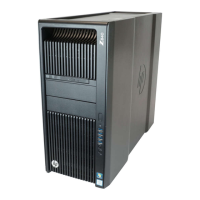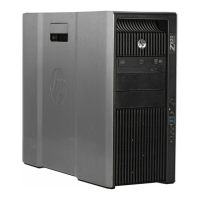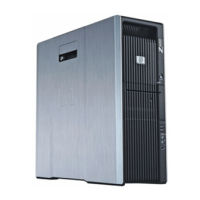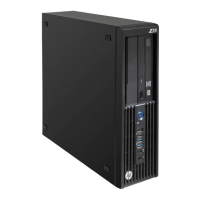17
Technical white paper | HP Z840 Workstation
5. RAID creation from within the OS using the Intel® Rapid Storage Technology
enterprise GUI.
The RSTe GUI provides an easy method for creating RAID arrays. The RSTe GUI is pre-installed on systems shipped from
the factory, and can also be installed from the latest driver package available on hp.com.
Launch Intel® Rapid Storage Technology enterprise GUI by navigating to it from the start menu, or press the Windows
key and then start typing “Intel” in the Box that appears. A short list should appear that contains “Intel Rapid Storage
Technology enterprise”. Click this item with the mouse to launch the GUI.
Click the “Create Volume…” button to start the guided RAID array creation process. Additional help is available on each
page of RAID creation process by clicking on “More help on this page” at the lower right corner of each page. A balloon
with a question mark inside will be displayed if help or suggestions are available for a specic topic. Click on the balloon
to display the help on the item in a new page.
Creating RAID Arrays on the SAS controller
RAID arrays on the SAS controller can be created through Option ROM (OROM), from EFI and Windows command line
utilities, or from a graphical user interface (GUI) within the Windows OS.
1. Pre-OS RAID creation through the Option ROM (OROM)
To access the OROM, press Ctrl-C as soon as you see “LSI Corporation MPT SAS2 BIOS” with a status of “Initializing”.
After the controller initialization, the OROM will launch. You can navigate through the OROM using the keys listed at the
bottom of the screen. A “/” between key options means any of the keys listed will perform the action.
To create a RAID volume on the SAS controller:
a) Use the Up/Down arrows to select a controller if more than one controller is shown and press Enter.
b) Use the Up/Down arrows to select “RAID Properties” and press Enter.
c) If you are presented with a screen showing “Manage Volume” highlighted, you have already created the maximum
number of RAID volumes with the drives available.
If you are presented with a screen showing “View Existing Volume” at the top with options for creating RAID volumes
listed below, you already have one RAID existing on the controller and can create another.
Use the Up/Down arrows to select the desired RAID type and press Enter.
d) Use the Up/Down/Right/Left arrows to navigate to RAID Disk Column and line corresponding to the drive you want
to include in the array and press Space to change from [No] to [Yes]. Continue the process to select all drives that you
want included in the array.
e) After you have selected all desired drives, press c to create the volume, and use the Up/Down arrows to select “Save
changes then exit this menu” and press Enter to conrm creation of the array.
f) After the array is created, you will be returned to the Adapter Properties screen. At this point you can use the Up/
Down arrows to select “RAID Properties“ again to view or modify existing volumes or create a new volume if
only one was originally created. If you are done, you can press Esc until you reach the screen with the “Exit the
Conguration Utility and Reboot” option. Use the Up/Down arrows to select “Exit the Conguration Utility and
Reboot” and press Enter.

